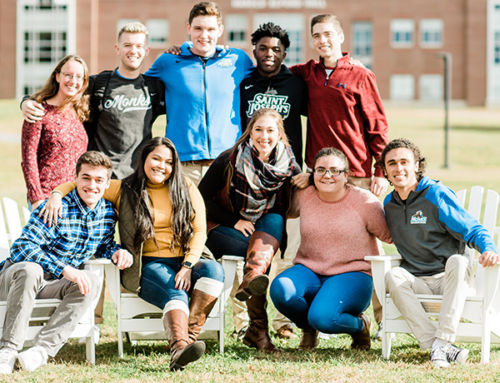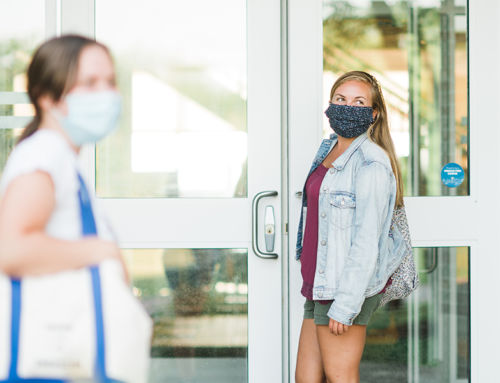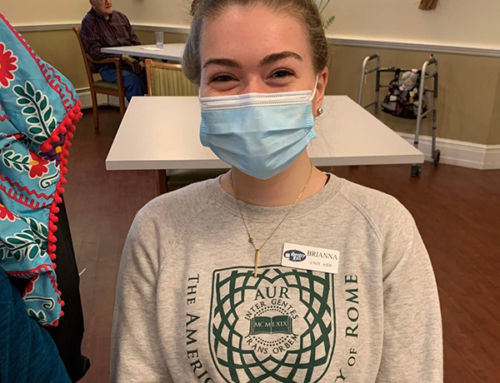While their peers throw on swimsuits to go to the beach, Cory Greenleaf ’16, Cassandra Leech ’16, and Jessica Selva ’17 are donning lab coats to spend their summer days conducting research projects as supported by the Maine Space Grant Consortium (MSGC) scholarship program. Each of the three scholarship recipients has dedicated the last few months to collecting field samples, running precise scientific tests, and analyzing data reports. Ultimately, the trio will represent Saint Joseph’s College to showcase their individual findings at the annual Northeast Undergraduate Research and Development Symposium (NURDS) sometime next March.
The topic of each student’s research varies widely: Cory Greenleaf, under the supervision of biology professor Beth Auger, PhD, is continuing the work of a former student to look at the growth of bacteria on human hands following contact with animals; Cassandra Leech is assisting biology professor Lucas Bernacki, PhD, with his own research examining the genetics of the aquatic invasive species milfoil; and Jessica Selva ’17 was tapped to help professor of marine and environmental science Greg Teegarden, PhD, examine phytoplankton as a means to better understand the impact of climate change on the Gulf of Maine. For Greenleaf, Leech, and Selva, the research process has allowed them to put their classroom knowledge to the test, learning new techniques, mastering unfamiliar equipment, and maybe for the first time experiencing the trial-and-error that is inherent to scientific research.
Greenleaf, a biology major who set out to build upon the research that Robert “Bobby” Michaud ’15 began as an undergrad, set his project apart from his peer’s previous work by comparing the different exposure time has on bacterial growth. At the time of the interview, Greenleaf had collected samples from 20 participants, nine of whom served as the control group. The other 11 were asked to interact with animals from Pearson’s Town Farm—think bunnies, sheep, goats, and chickens—for increments of five minutes and 20 minutes, sanitizing their hands in between. From the samples collected, Greenleaf used a method called gram staining to distinguish bacteria by the chemical and physical properties of their cell walls in order to identify infectious bacteria resulting from animal contact.
The result? “The total number of morphotypes was higher for the 20 minutes than in the five minutes, but I think I would have preferred to do more time, like an hour,” says Greenleaf, who are already toying with the idea of picking back up this line of research during the school year. “I think I’m going to continue on with this for my senior seminar. I’d have to change it up a bit, but there are ways I could look at fungal growth or do different levels of exposure.”
Cassandra Leech was similarly enthused about keeping an eye on Dr. Bernacki’s research even after her participation as an MSGC intern comes to a conclusion this summer. As a chemistry major, Leech had to be a quick study to pick up the population genetics involved in her research, which is the first stage in a multi-year project proposed by Dr. Bernacki to learn more about variable-leaf watermilfoil in the hopes of eradicating it from Maine’s lakes. Bernacki and Leech spent the summer collecting samples from Thompson Lake, Sebago Lake, and Little Sebago in order to determine if the plants populating these bodies of water are clonal or unique individuals, which will inform recommendations for eradication down the line.
“It was absolutely mind-blowing to see what it would do—it would cover a whole river!” recounts Leech. “You can’t fish in it, you can’t swim in it, and it’ll drive property prices down. This project is showing me that there are so many more paths and applications for research—even if I continue on with chemistry [after graduation]—than I previously considered.”
The third student, Jessica Selva, came to her research project sort of by accident when Dr. Teegarden asked her to assist him this summer after another student had to back out of the program unexpectedly. “She picked up the process of what we do faster than anyone I’ve seen,” says Dr. Teegarden of Selva’s ability to get up to speed. With her professor’s supervision, Selva has been collecting and analyzing phytoplankton (microalgae) from the test site in Harpswell Sound, Casco Bay, looking at the abundance and species composition of the samples. Selva's findings will then be used by researchers at Bowdoin College to develop and calibrate optical sensors that will be attached to moored buoys in order to continuously monitor fluctuations in algae blooms, which can be indicative of climate changes.
Like Greenleaf and Leech, Selva, who is technically a rising junior but only just completed her first year at Saint Joseph’s as a transfer student, also notes how her experience assisting Dr. Teagarden has been eye-opening.
“I know that in the environmental major, you can either take oceanography or limnology (the study of lakes), and I’m certainly now interested in taking oceanography and doing more with the marine science electives. I’m taking [college] one step at a time, but I definitely plan to apply for more internships now that I know what they’re like.”
The Maine Space Grant Consortium supports educational opportunities for K-12 up to graduate students, with the goal of increasing the participation of Maine undergraduate and graduate students in STEM (science, technology, engineering, and mathematics) research conducted by the NASA field centers and associates. The purpose of the scholarship and fellowship program is to provide research opportunities to undergraduate and graduate students in STEM areas that are of interest to NASA. Awards are made on a competitive basis to students who are enrolled full time in a STEM field at our affiliated academic institutions. For more information, visit their website at http://www.msgc.org.


